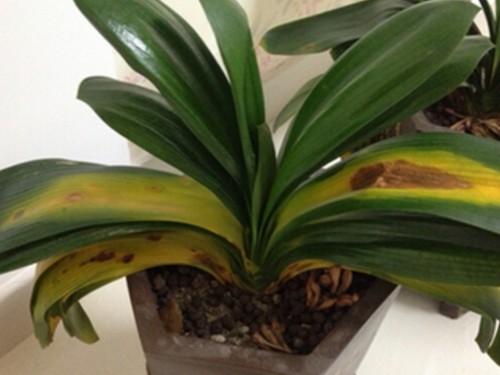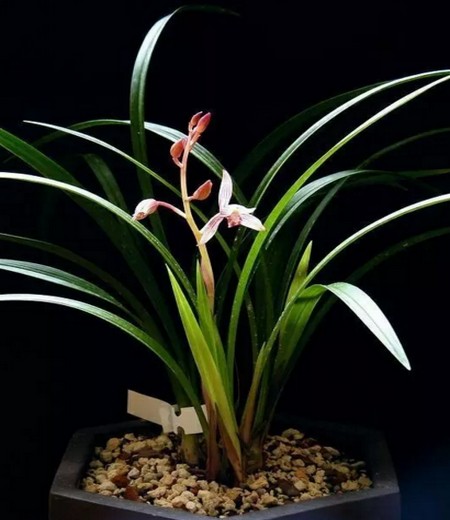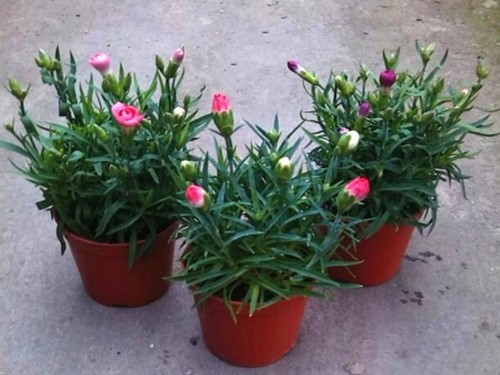What if the leaves of potted Magnolia turn yellow?
Some netizens asked what to do if the leaves of Cymbidium turn yellow. Why do the leaves of Cymbidium turn yellow? There are several situations in which the leaves of Cymbidium are yellow. if the bottom leaves grow new roots from the axils of the leaves, it is a normal metabolism to make the leaves yellow. One situation is that the leaves turn yellow without new roots in the axils of the leaves, mostly due to the soil quality, poor air permeability, too much fertilizer or poor control of watering dry humidity, which may make the leaves of Cymbidium yellow. If the water is impermeable and the root tip is short of moisture, it will make the leaf tip yellow and dry. If this happens, it must be watered thoroughly. In summer, a small basin of water can sit at the bottom of the flowerpot every 7-10 days, so that it can be watered thoroughly. This is called flooding.

Another situation is that yellow spots of different sizes appear on both sides of the leaves, which is called brown spot. This is mainly due to the relatively healthy soil and excessive fertilizer application. Generally speaking, rotten leaf soil should be used in basin soil, and its air permeability is better, especially in summer, thin fertilizer should be applied frequently, and fertilizer and water should not be dropped on the leaves, so as to prevent the occurrence of spot disease. In another case, due to sufficient sunshine and high temperature in summer, if the magnolia is exposed to the sun, sunburn will occur. The light leaves turn yellow and the heavy ones wilt. Shading should be taken in summer, put in a ventilated place, the degree of shade should be 50%, and the south window of the family can be shaded with a layer of gauze.
1. The light is not suitable
A gentleman's orchid likes to be half-overcast and avoids bright light. If it is maintained in strong light, especially in summer on the windowsill or balcony facing south, it is extremely easy to cause sunburn, causing the leaves of Magnolia to be rough and dull, yellowing or showing yellowish white from the side; if the potted flowers are cultivated in the shade for a long time, where you can't see or rarely see light, it's easy to see new leaves thinning and showing yellowish green or yellow. Therefore, it is appropriate to put the orchid on the north balcony or indoor with bright scattered light in summer, give more light in the morning and evening in spring and autumn, and put in sufficient indoor light in winter.
2. The temperature is too high or too low
When the air temperature exceeds 30 ℃, the air is dry, but fails to take cooling and humidifying measures, and put in the hot and unventilated indoor or outdoor in hot summer, it is easy to make the leaves of Cymbidium yellowed. In winter, because the room temperature is too low (less than 10 ℃) or is directly attacked by the cold wind, the leaves that suffer from the cold will turn yellow and gradually scorch.
3. Improper use of soil
When planting magnolia with clayey soil or soil containing more limestone, when the physical and chemical properties of the soil are poor, the permeability and drainage performance is poor, coupled with excessive watering and fertilization, it is very easy to cause rotten roots and cause the leaves to turn yellow; some use unfermented horse dung or other organic fertilizer, which is added to the basin after fermentation to dissipate heat, burn the roots and cause the leaves to scorch gradually. Therefore, the soil used in pots should be loose, fertile, slightly acidic soil with good drainage and air permeability.
4. Improper water and fertilizer
In the process of maintenance, the basin soil is too dry and too wet, especially often too wet, which will cause the leaves to turn yellow and scorch. When potted flowers are often drenched in rain or washed with leaf dust in outdoor summer, water will be poured into the middle of the new leaves many times, which will cause the new leaves in the middle to rot and scorch. Application of too much, too thick or unfermented manure, because the root system can not absorb, resulting in root burning, leaves will be withered and yellowed. Excessive application of human nitrogen fertilizer or excessive mixing of bean cake crumbs into the soil as base fertilizer will also produce the same fertilizer damage. In addition, in the process of fertilization, accidentally dripping fertilizer on the plant and leaves, not timely cleaning, will also produce macula or scorch on the leaf surface.
Due to the above reasons, it will be accompanied by ulceration, which is caused by bacterial infection. In order to prevent or reduce the above diseases, on the one hand, we should use soil, water and fertilizer correctly; on the other hand, we should pay attention to the environment, temperature and light with the change of seasons.
The yellowing of the leaves of Cymbidium is an abnormal phenomenon that often occurs in domestic. This is mainly due to a physiological disease caused by improper management, which, in serious cases, can lead to the death of the whole orchid. Corresponding prevention and treatment methods can be taken according to different causes.
Reason 1: apply raw fertilizer or concentrated fertilizer
The fleshy roots of Cymbidium are stout, fat and tender, and it is most forbidden to apply too much thick fertilizer or unripe organic manure; otherwise, it is easy to burn roots, light ones cause yellow leaves and scorched leaves, and heavy ones lead to red yellow death of the whole plant.
Treatment method:
① immediately increased the amount of water and times of watering to dilute the rich fertilizer. Prevent stagnant water.
If ② is the harm caused by raw fertilizer, it is necessary to immediately pour the pot to change the soil, pour out the plant, first rinse the root system, and cut off the injured root, then smear the wound with charcoal powder, and then replant.
Reason 2: hot sun exposure
Gentleman orchids like a cool and humid environment. If the orchid is placed in a hot and unventilated place, or in a high-temperature and dry environment plus hot sun exposure, which inhibits the normal activity of enzymes in the plant and destroys the chlorophyll in the leaves, it will cause the leaves to turn yellow. especially the leaves of young leaves are yellowing or the edges of leaves are scorched.
Treatment method:
① will place the potted flowers in a cool and ventilated place in time.
② shade to prevent direct sunlight.
③ sprayed water around the orchid plant and on the ground to increase humidity and lower temperature.
Reason 3: poor drainage
Watering too often or continuous rain for a long time, the basin soil is in a state of stagnant water for a long time, resulting in the reduction of oxygen in the soil, which can not meet the needs, resulting in abnormal life activities of Magnolia, root rot, resulting in the tip of tender leaves turning yellow, and then the old leaves turning yellow.
Three reasons for the treatment:
① immediately controls watering.
② avoids the rain.
③ stopped fertilizing.
④ often loosens the soil, which increases the oxygen content of the soil, improves the absorption capacity of roots, and promotes plant growth.
Reason 4: soil drought
The basin soil is too dry and lacks moisture. When the magnolia is serious, the old leaves will die and the new leaves will be dry.
Treatment method:
① watered properly first.
② should pay more attention to balanced watering when the temperature is high and dry.
③ can be transferred to normal water and fertilizer management after the orchid gradually recovers its vitality.
④ usually keeps the basin soil moist and loose.
Time: 2019-06-01 Click:
- Prev

Culture methods and matters needing attention of potted sword orchid
Sword orchid, the scientific name is Gladiolus, belongs to the bulbous plant of Cucurbitaceae, the original species is native to South Africa. The flower stem is higher than the leaf, and the Corolla tube is in the shape of an expanded funnel, and the flower colors are red, yellow, purple, white, blue and other monochrome or multi-color varieties. It is widely cultivated all over the world. So, is the sword orchid easy to raise? What are the breeding methods?
- Next

How to grow carnations in potted plants
Simple and elegant carnations are always reminiscent of maternal love. As Mother's Day approaches, follow the editor to learn how to raise potted carnations. In the coming year, I will send a bunch of hand-planted carnations to my mother. Think about how warm it is! Friends who have never planted carnations have such worries.
Related
- Fuxing push coffee new agricultural production and marketing class: lack of small-scale processing plants
- Jujube rice field leisure farm deep ploughing Yilan for five years to create a space for organic food and play
- Nongyu Farm-A trial of organic papaya for brave women with advanced technology
- Four points for attention in the prevention and control of diseases and insect pests of edible fungi
- How to add nutrient solution to Edible Fungi
- Is there any good way to control edible fungus mites?
- Open Inoculation Technology of Edible Fungi
- Is there any clever way to use fertilizer for edible fungus in winter?
- What agents are used to kill the pathogens of edible fungi in the mushroom shed?
- Rapid drying of Edible Fungi

